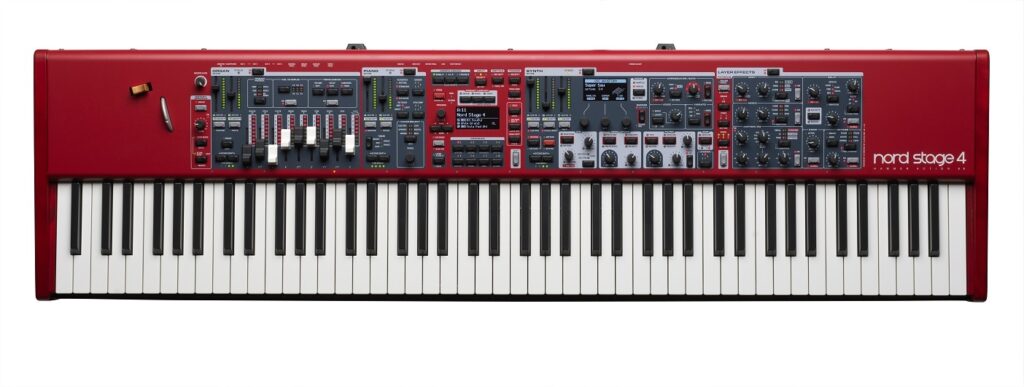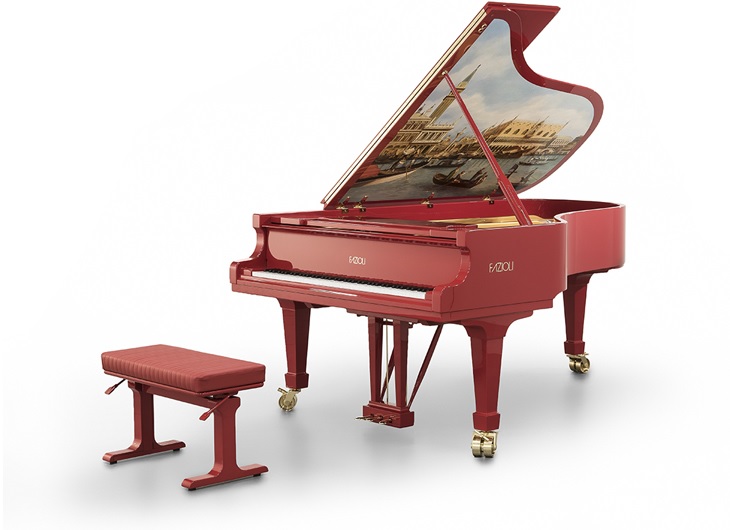The Yamaha Montage announcement got me thinking about the kind of “all-in-one” keyboard that I would like to play. I still enjoy playing my Nord Electro 2, but the NE2 falls short as an all-in-one. My all-in-one needs to be strong in B3 organ, pipe organ, acoustic sounds, and to a lesser extent, electric pianos. Ideally, the action would be a waterfall keyboard or a good quality “synth action” keyboard. I do not need the weight or expense of a hammer action keyboard. And speaking of weight, the all-in-one should be as far under 20 pounds (about 10 kg) as possible.
The current Nord Electro 5d has gotten very favorable reviews. As one would expect of Nord, it is one of the leading clonewheels, has very good electric pianos, and plays back sampled acoustic instruments from the Nord Sample Library. The 5d has a waterfall keyboard, sliding drawbars, and a nice clear OLED display. The 5d can layer and split voices with a few limitations. Finally, musicians can create sample-based voices of their own using the Nord Sample Editor.
Looks great and the on-line demos sound good! Now, where can I find one to try? This is a dilemma faced by many musicians today and it’s not only trying to find Nord products on display in store. Brick and mortar stores cannot afford to keep a wide spectrum of keyboards on the floor just in case someone feels the urge to try out a new ax. Keyboard sales are not that hot — guitars out-sell keyboards by 5 to 1 when measured in dollar sales volume. Plus, pro-level keyboards are expensive and that’s a lot of money to tie up in inventory.
Fortunately, the nearest GC (the store whose name I dare not speak) had a Nord Stage 2 ex 88 on the floor. So, I grabbed my audition folder and took a drive. I’m glad that I did. (Wednesday night at 8PM is a good time. No shredders and head cases.)
Most NE5 reviews focus on the clonewheel and electric piano sounds. Nord Stage reviews put the synthesizer section to the test, too. My review is different because I decided to concentrate on the quality of the sampled acoustic instruments. One leap of faith is needed: the acoustic instruments on the Stage are not doctored up by the synthesizer when compared to the NE5. Still, a favorable response to the Stage has encouraged me to look for an NE5d to try, possibly by going to the downtown Boston store. (A day trip for me.)
I scrolled through the Stage’s presets and pulled an appropriate lead sheet from my audition folder whenever I found a voice that I wanted to try. I played mainly hymns and liturgical service music from our repetoire: contemporary hymns, traditional hymns, gospel hymns, etc. Yeah, some B3 got in there. I’m weak.
Without being long-winded, here’s a quick rundown.
- The handfull of pipe organ sounds (big church and chapel) are pleasing and useful. The big cathedral sounds are not overdone, one of my biggest complaints with typical synth “church organs.”
- Strings? You got ’em. Big, small, sections, solo. The majority of the string voices are very playable. Big strings that are rich without getting screechy in the high end.
- The orchestra brass ensembles are generally darned good. The trombone section is too loud and brash for church. Softer French horn voices are needed, too. The few horn voices are borderline bright and loud — I need mellow. The pop brass ensembles sound terrific. (“Knock On Wood,” anyone?)
- Woodwinds, too, are a mixed bag. The woodwind sections are good and playable. The orchestra solo winds (except the flute) are terrible. If I bought an NE5d today, I would cobble together my own solo oboe and clarinet. Although it wasn’t a focus, I played one sax patch that was pretty decent and I wouldn’t be embarrassed to play it in public.
- B3. Nord groovy as usual. The B sounded darker compared to my memory of the NE2. The Stage has the fast/slow switch on the left where it should be. Nord needs to make the switch BIGGER as it is really difficult to find and hit. (I switch speeds via foot pedal normally, so this is a minor niggle.)
- Electric pianos, thumbs up.
The Nord Stage 2 ex 88 has a hammer action keyboard. I was pleasantly surprised to find it easy to play organ with this action. The keys did not cut my hand when doing palm swipes and I didn’t have too much trouble playing with a legato touch. Nice work, Nord.
You might reasonable ask, “Why use sampled pipe organ when the NE5d has modeled pipe organ?” The modeled organ solely consists of principal pipes. I think I could use the modeled organ to lead congregational singing as principals are a clear, supportive voice. However, after listening to the demos, the principal pipes alone get “same-y, same-y” fast. I hope Nord continues their work on modeled pipes as the current implementation needs a more varied sound (e.g., reed voices, and so forth).
Overall, the Nord Stage 2 88 left me with a very favorable impression. Despite the shortcomings mentioned above, the acoustic instruments are pro-quality and suitable for liturgical music. I will seek and find a Nord Electro 5d for trial. It’s worth the effort. The Nord Stage 2 ex Compact (73-key waterfall) has a street price around $3,600 USD. The Yamaha Montage 7 (FSX action) has a street price around $3,500 USD. I see a shoot-out on the horizon…


